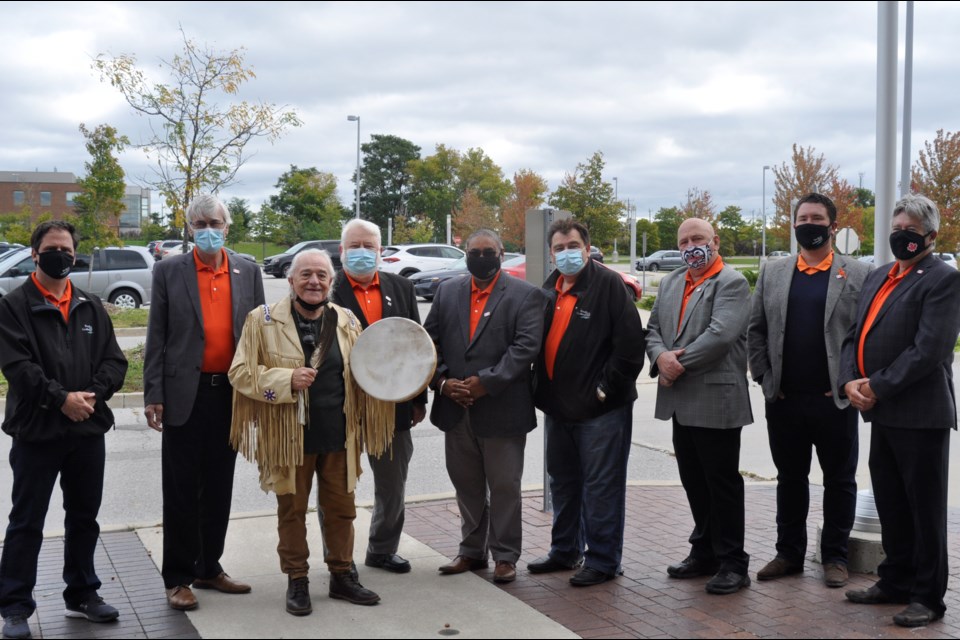It was a beautiful, crisp, and solemn fall morning during the National Truth and Reconciliation service held in front of the Bradford Leisure Centre, honouring the lost Indigenous children and survivors of residential schools, their families, and communities.
“We are here on September 30th to recognize the National Day of Truth and Reconciliation,” began BWG Mayor Rob Keffer who played an Ojibwa version of the Canadian National anthem at the start of the service. “The Town of Bradford West Gwillimbury is dedicated to honouring Indigenous history and culture and is committed to coming together to heal, create future prosperity, and respect and understanding in all of our communities.”
The holiday observes the impacts of the senseless atrocities that occurred in Canadian residential schools in the 1870s where thousands of Indigenous children were removed from their homes, abused, and surreptitiously murdered, until 1997 when the last residential school was finally closed.
The Bradford service included a flag raising and lowering of the Canadian-Indigenous flag (originally designed by Kwakwaka’wakw artist Curtis Wilson from Vancouver Island, British Columbia), as well as a smudging ceremony performed by Bond Head resident and First Nation storyteller Doug Gray (White Eagle).
White Eagle led members of BWG Council and local residents in a blessing and sacred ceremonial smudging, encouraging everyone to place their hand over the heart while waving the other hand around their head three times.
“Some never saw their parents again,” expressed White Eagle. “We’re here to remember those families, those children. Truth and reconciliation begins with the family, with each one of us in our homes. It’s learning to be honest, and sometimes honesty is painful.”
White Eagle brought his traditional paddle (oar) which he extended out to the crowd as an invitation to repair and reconnect with the Indigenous communities.
“When we arrive here on the sacred star, we all get a canoe but you don’t get a paddle, because as human beings we want to control – we have this insatiable need to control things – and the universe doesn’t act like that. It unfolds. And what we have to do is listen and join in with all of the different sounds.”
BWG Coun. Mark Contois (who is originally from Beausoleil First Nation) and three other volunteers each held the corner of a colourful, quilted blanket to honour the Indigenous grandmothers who made traditional sacred blankets for ceremonies.
“Honour the elders, honour those victims who are unable to speak for themselves. We honour them now in a moment of silence,” shared White Eagle, chanting the sacred term “Miigwetch” which means ‘thank you’ in Anishinaabemowin (also known as Ojibwa).
White Eagle also honoured 104-year-old Markham resident Vidya Vati Mehta, a woman who travelled all over the world and taught women how to become midwives. She delivered close to 1000 children in her lifetime, he shared.
“Today, it’s appropriate that we place her name on the elder’s chair and remember she was ahead of her time because in those times women were not given the voice,” shares White Eagle. “Because of her, the world is a better place.”
Many local residents and families came out to support the event wearing their orange shirts, including new parents Kaitlyn and Brian Bollmann who brought their one-month-old newborn, Theodore.
Theodore was blessed during the service by White Eagle and given the name "Young Raven" as a symbol of honour to all newborns entering the world.
“We have to understand that we were once all children, and so every child matters,” noted White Eagle. “Today we are free… we’re free to speak our own language, we’re free to grow our hair long again, we’re free because we’re born free – the sun has broken through the darkness.”
To date, Canada has recovered over 6,509 remains of Indigenous children across the country from the locations of former residential schools that were funded by the Canadian Government and facilitated by Christian Orthodox Churches at the time.



